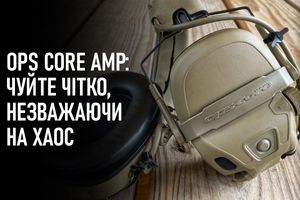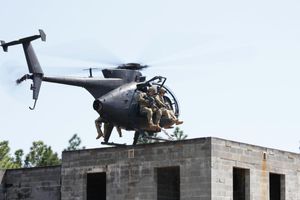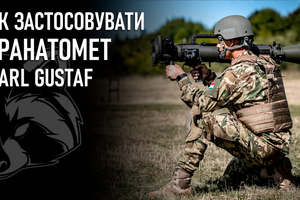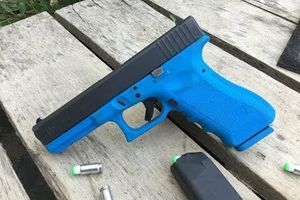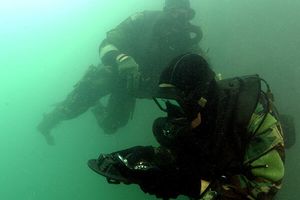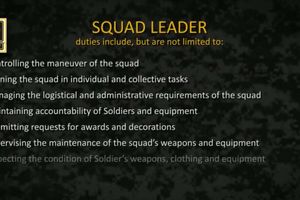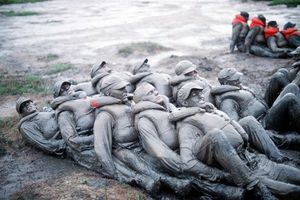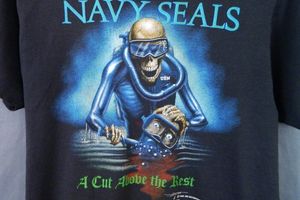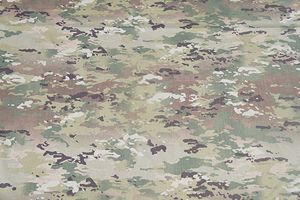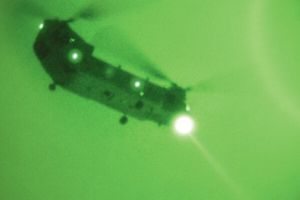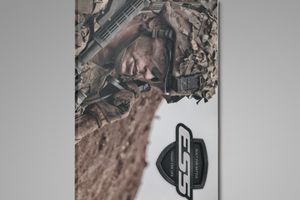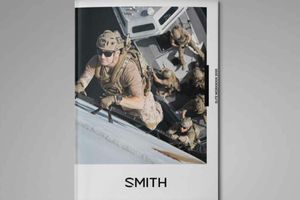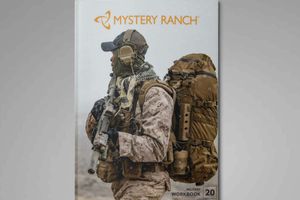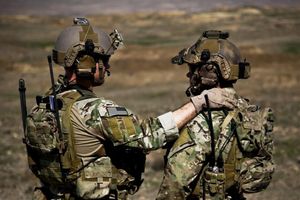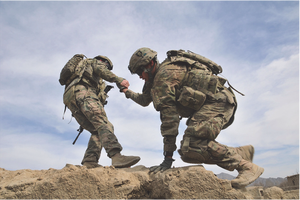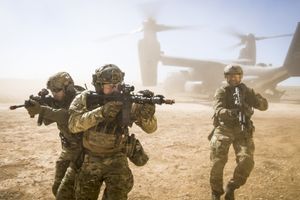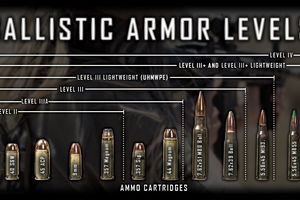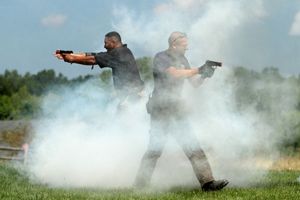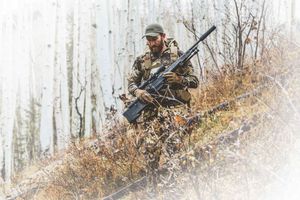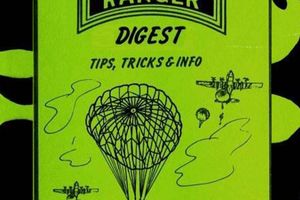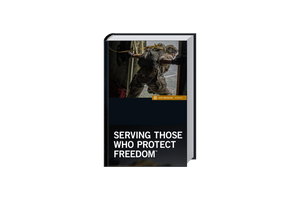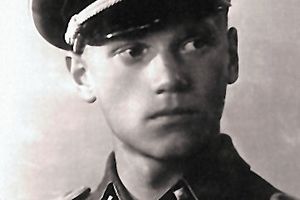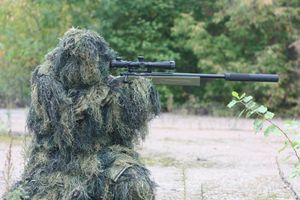Previous Chapter 2: Confidence
"The Three-Foot World"
Fear
My body was frozen against the smooth rock face.
I couldn’t move no matter how much I willed myself to get going. I could feel my arms shaking from the weight. Sweat ran down my face and my palms were damp, making my attempt to hold on even harder. My eyes shifted to the right and caught a glimpse of the glittering Las Vegas Strip far in the distance. I quickly closed my eyes, shaking my head and hoping when I opened them again I’d be in a better place.
When I finally opened my eyes, I was still more than one hundred and fifty feet up, barely hanging on to my hand- and footholds. I had a rope hooked to me, but I had no intention of testing its strength, because that meant falling, which was what I was scared of in the first place.
I had been a SEAL for four years, but I still hadn’t mastered my intense fear of heights. The rock face looked like a sheet of brown glass, with no place to get a handhold. My mind and body were in a full-on civil war. My mind screamed at me to move, but my body refused. All I could do was hold on and curse myself for losing one hundred percent of my focus.
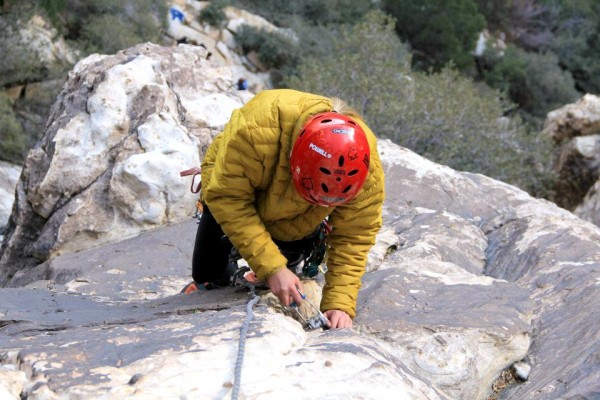
By this early point in my career, I’d been on one training deployment to the Pacific and my platoon was training for its next rotation, which would be to Iraq, and which would be my first chance to get into combat. As we got toward the end of the training cycle, one of the last trips was to Red Rock Canyon outside of Las Vegas. I’d gone on one other climbing trip, where I learned the basics, but on this trip we were going to learn how to lead climb and set our own protection.
I’ve never been a fan of heights, and I sure wasn’t thinking about falling or my fear of heights when I signed up for the trip. I was only thinking of downtime in Vegas and blowing off steam before heading to Iraq.
The night we arrived, we hit the Strip and enjoyed all Vegas had to offer. After a few hours of sleep—more like a quick nap—we drove out to the climbing site. We hired civilian instructors and they watched in awe as we pulled new, top-shelf gear out of our rental cars. I had the best gear that money could buy, and the command had hired the best instructors in the world, but I had none of the skills. I was definitely out of my league, especially compared to the professional instructors.
The five instructors were gathered in a group near the parking lot when we arrived. They wore ratty shorts, shirts, and sandals. Climbers are inherently poor, especially the good ones, because climbing is all they do. These guys don’t have any other hobbies. I’d seen the same thing with skydivers. All of their money went right back into buying gear and doing the sport that they loved. Our instructors came over to help with the gear, shaking our hands and welcoming us to the canyon. Their hands were callused from hours on the rock face.
The first two days were no big deal. It was more of a refresher, with nothing too high or hard to climb. We had to make sure that everyone remembered the safety precautions and basics we had learned previously before getting into the newer, more demanding climbing the last day.
We split up into two-man teams. Each team had its own instructor. I was paired with Jeff, one of the newer SEALs in the platoon. He wasn’t a fan of heights either. There was no way I was going to show my fear, and Jeff was trying hard to hide his nerves from me as well. If your teammates ever see a weakness, you’ll never hear the end of it.
Our “billy-goat” instructor led us over to one of the climbing routes. He was short and stocky, with leathery skin and a long goatee. He had the strongest handshake I’d ever felt. A North Face beanie covered his scraggly brown hair. He was an ex-con who’d been to jail for assault. He’d beat up the guy who was banging his wife, or at least that’s what he told us during one of the breaks.
It was decided that I’d go first while Jeff would belay as I climbed. I kept up a steady soundtrack of what I was doing as I inched up the cliff face. None of my talking made sense. It was sort of gibberish, but it was comforting for me. I am sure it annoyed Jeff.
“Oh yeah, lucky cam number four,” I said, holding the cam in my open hand. “Lucky blue number four.”
Each camming device was a different color, based on the size. I set my own “pro,” or my own protection, as I climbed. That meant it was up to me to do it right, because if I fell—something I was trying not to think about at the time—the rope would be pulled taut in the camming devices. We were taught to place the cams roughly every ten feet into cracks in the rock face and ledges. If I fell with my closest cam being ten feet below me, I’d fall a total of twenty feet before the rope caught me. If I’d placed that cam wrong, I didn’t want to think about falling to the next one below that.
I decided to put them in at five-foot intervals as I climbed, in an attempt to make myself feel more comfortable.
“Yep, every five feet works great,” I said to myself as I set another cam into the rock face.
I made it up the first pitch without issue and belayed Jeff as he climbed up. Jeff led the next route, and I stayed below him to belay his climb. Once we both had several chances to practice our lead climbing techniques, the instructor took us up to a bigger wall. The shadow of the wall seemed to stretch out for miles. I tried not to look up to the top of the cliff, which blocked out the sun.
“You’re first,” the instructor said to me.
I didn’t have much to say this time. I was too nervous to talk. This rock face was much bigger and flatter than the others we had climbed. There were half the hand- and footholds available, and we would have to stay very focused on choosing a clean route up the face.
I climbed quickly at first, easily finding hand- and footholds. As I climbed, I set pro into cracks or pockets in the rocks. I had been in such a good rhythm between climbing and setting my pro that I hadn’t noticed I was using entirely too many camming devices and was about to run out. Placing my last cam into a big crack in the rock, I was officially stuck. I couldn’t go any higher. To be honest, I didn’t want to.
For the first time since I started to climb, I took my eyes off the rock face in front of me and started to look around. I was pretty fucking high up. I could see the Las Vegas Strip and the desert stretching all the way to the horizon. I glanced down and saw Jeff, now a lot smaller. He looked like a garden gnome.
Any chance I had of keeping my fear in control was slipping away, a lot like my hold on the rock.
I wished I was anywhere else as I looked up into the crystal-clear blue sky. I was nervous and could feel myself losing focus on where my hand- and footholds should be. I lost “front sight focus.” When a SEAL shoots, we talk about focusing on the front sight of our pistol just before we pull the trigger because if it is lined up on the target and in focus, the bullet will hit. If you lose that front sight focus, you’ll miss, simple as that.
But all I could think about was the cold rock face, how high I was off the ground, and the instructor climbing up to me without a rope. I could also hear Jeff on the ground yelling up to me.
“You need me to climb up there and save you?” Jeff said in a smartass tone.
I struggled to find a new handhold, but my fingers were tired.
“I’m about to slip and fall,” I thought.
To my left, I heard something scrape against the rocks. I’d been so focused on my situation that I’d forgotten all about our instructor. I’d catch him climbing around like Spider-Man as he waited for me to set the next cam. It made me nervous watching him because he didn’t use a rope.
The guide finally scampered up to me. Dangling from a harness across his chest were about a half dozen cams. His crazy billy-goat ass had climbed down and collected up all the unneeded cams I had set below so he could pass them off to me and I could keep climbing. And he’d done it all without any rope or pro of his own, free-climbing around me without giving it a second thought. Somehow that fact wasn’t comforting.
A cigarette dangled from his lips as he hung there next to me. With one hand on the rock face, the instructor took a drag of his cigarette and exhaled a cloud of blue smoke. It was obvious I was struggling.
“Hey, man,” he said in a lazy, raspy voice. “Just stay in your three-foot world.”
I was a couple of hundred feet up the rock face and I could barely think, let alone decipher his cryptic advice.
“What the hell are you talking about, bro?”
“Only focus on your three-foot world,” he said. “Focus on what you can affect. You keep looking around, and none of that shit can help you right now, can it?”
I shook my head no.
“You’re calculating how far you’re going to fall,” the instructor said. “You’re looking down at Jeff, but he’s not going to come up and help. You’re looking out at the Strip. What are you going to do, gamble your way to the top? Don’t look at me. I’m not going to help you either. This is up to you. You’re climbing this rock. Stay in your three-foot world.”
I’ll never forget those words: “Stay in your three-foot world.”
It was the only way I got off the rock face. Now reloaded with cams, I focused on wedging one into the nearest crevice. I slid the rope through the carabiner and started to climb again. My focus never went farther than my next hand- or foothold. All the beauty of the desert or Las Vegas sparkling in the distance was lost on me. But I could tell you every crack in the rock. I was so focused it shocked me when my hand reached over the lip of the cliff at the top of the climb.
I finished the climbing trip that week with a new perspective. Staying in my three-foot world became a mantra for me. It is liberating once you let go of the things that you can’t control. It seems to work for just about any situation. The three-foot world helped me get through everything from climbing to skydiving to night dives where the only way you can keep your bearings is to focus on the glowing compass on your wrist.
Of course, the other part of being a SEAL that makes a fear of heights a little bit of a problem is skydiving. I had been to jump school even before joining the Navy, but I was uneasy with every jump and it took years before I started to love it.
I remember one jump, just after I graduated S&T. My troop was on a military free-fall training trip in Arizona. I was “new meat,” which meant I was the new guy. I had to jump all the gear the more senior guys didn’t want to jump, like the collapsible ladder, sledgehammers, and extra ammunition.
The inside of the C-130 was lit by red lights. I couldn’t stand up straight as I shuffled onto the plane. It was hot in the cabin as we took off and climbed to twenty thousand feet above the Arizona desert. My mouth was dry and my breathing was ragged. The backpack I was jumping was new, and much bigger than the pack I usually used. It sat at my feet, full of ammunition and extra gear. The straps from the rest of my sixty pounds of gear cut into my skin.
I tried to adjust the weight of the pack, hoping to balance it better, but I didn’t have any luck. My body ached from dragging the pack, oxygen tank, and parachutes onto the plane. I rolled my neck, working out the kinks from the heavy helmet and night vision goggles strapped to my head. I just didn’t feel comfortable at all. Instead of focusing on what I had to do, I complained to myself about how much everything sucked. All I wanted to do was jump because at least I’d be closer to getting all of the gear off.
Most of the time we wear so much gear that it literally takes all the fun out of something. Jumping at a civilian drop zone wearing a small “sport parachute” can be fun. For our work jumps, I had a minimum of sixty pounds of personal combat gear strapped to me. Add another one hundred pounds from the parachute, an oxygen bottle, and a mask, and then strap an additional sixty-pound backpack of extra “new meat” gear in front of me, and I was weighted down with well over two hundred pounds of gear, doubling my weight.
All my attention was focused on my discomfort when it should have been on the task at hand, a proper exit from the aircraft and the rest of the jump. We were conducting a night jump into an unknown drop zone, meaning we hadn’t been there before. I’d studied it on the map—an intersection of two dirt roads near the base of a mountain—but I wouldn’t get eyes on it until I was under canopy and looking through my night vision goggles. All I had to do was exit the plane; after a several-second delay, open my chute; and fall into line behind the lead jumper; and, if all went well, we would all land together. We all had the landing zone programmed into the GPS on our wrists in case we weren’t able to link up with the lead jumper, but that was usually an unused contingency plan.
It was the lead jumper’s job to guide the entire stack to the ground safely. When you are flying collapsible canopies in the middle of the night sky with more than twenty other SEALs, this is easier said than done. Since parachutes aren’t rigid like the wing of a hang glider or an airplane, if two parachutes collide with each other, the chutes collapse or wrap around each other, causing you to fall to your death.
I scanned the cabin, looking at my teammates, who were just shadows in the red glow of the lights by the ramp. Most of the guys just sat there silently, occasionally shifting the weight on their laps. It was impossible to see faces or expressions, but no one looked like I felt, which was nervous.
I fiddled with my oxygen tank and repositioned my rifle for the third time. I was so wrapped up in my own suckfest, the whoosh of air as the ramp slowly opened startled me. The jumpmaster gave the signal for “Ramp” and then “Stand up.” My teammates, like old men under all the gear, slowly got to their feet and shuffled toward the ramp.
The wind was deafening. We huddled near the edge and waited for the green light to jump. For a second, it dawned on me that I was inside one of the movies that I’d watched growing up. It was surreal, as I looked over my brothers lined up in front of me. I’d worked my ass off to be here.
Had I really made it?
The stars bobbed up and down as the plane settled into its cruising altitude. At this altitude, the black sky was littered so densely with stars it was hard to tell them apart. Beneath us, the clouds slipped by, occasionally breaking open, revealing the black desert below. It was so dark that it was hard to tell the difference between the lights from buildings on the ground and the stars shining in the night sky. I looked at the green numbers on my altimeter.
We got the “One minute” call from the jumpmaster and my mind began to wander. I could feel myself starting to question if I could really handle what was about to come my way. The what-ifs started to circle in my mind.
“What if I screw up my exit?”
“What if I didn’t pack my parachute correctly and it doesn’t open like it should?”
“What if I can’t find the lead jumper and I am lost in the night sky?”
Then the green “go” light lit up.
“Green light. Jumper, go!”
My teammates waddled forward and disappeared off the ramp. Just like in the fifty-meter underwater swim, I needed to force all the what-ifs out of my mind and focus. As my boots reached the lip of the ramp, my mind was still racing. I wasn’t focused.
I squared my feet on the ramp with my toes hanging slightly over the edge and pushed off. Nothing about my exit was relaxed or graceful. I was stiff off the ramp and my body position was bad from the start. My head should have been up, and my arms and legs out, controlling my body angle. But as soon as I hit the jet stream flowing off the plane, I started to spin. A spin is the last thing you want exiting an aircraft, especially when you’re carrying a lot of weight from extra gear.
The stars were just a smear of light as I rotated like a top. I struggled to get my bearings. A feeling of panic welled up from my chest. I was gulping down air as I flailed in a desperate attempt to stop the spinning. I was in trouble, but I couldn’t clear my mind and think, which only compounded my problems.
Instead of worrying about my body position, instead of worrying about getting under control and getting into a stable position, belly to the earth, all I could think was how I had to save myself.
“This is not good; this is not what should be happening right now,” went around in my head in a loop.
Out of pure instinct driven by fear, I reached in and pulled the handle to release my main chute. It was too early to pull my chute and I was in an uncontrolled spin; it was the last thing I should have done, but there was no reversing it now. I could feel the chute jump off my back as it came out of the container. In the split second I waited for the jerk of the parachute filling with air, I scolded myself for being so unfocused. I knew everything I did wrong. I fucked up my exit from the aircraft. My body position was stiff and I’d caused the spin to occur. I didn’t stop the spin before pulling my chute. I panicked and simply stopped thinking and acting and instead made another mistake by not getting into the proper position before I pulled. I knew better than to make any of those mistakes.
I felt the parachute jerk and the spinning begin to slow, but when I looked up to check my canopy, I couldn’t lift my head. The risers that led from my harness up to the parachute blocked it. I could feel the risers pressing against my neck. I thrashed my head back and forth, hoping to wiggle free, but it only put more pressure on the back of my head.
Something was very wrong.
All I could hear was my breathing through my oxygen mask and the flapping of the parachute above me. I took a quick look at my altimeter. I was finally remembering all the basic skydiving rules that I had been taught.
“Always be altitude aware.”
I was at eighteen thousand feet, so I had plenty of altitude and time to fix the problem with my chute. But not much time, if I wanted to stay with the others. By now, my teammates were above me, I figured, and with good parachutes they were probably already flying toward the target.
I could hear the snapping of the parachute above me as I started to bank into a lazy turn. At first it was a slow circle, but by the second rotation I was picking up speed. I’d seen the videos of guys with parachutes rolled tight like cigarettes burning into the ground. My parachute had some lift, because I wasn’t falling like a meteor. But I had no ability to control my chute, and the spinning was getting faster and faster. I feared if the spinning became too violent I’d lose consciousness.
I had to act.
All of a sudden my mind started focusing on my emergency procedures, snapping me into my three-foot world. Up until this point I was worried about my comfort and how the older guys were going to make fun of me for fucking up my exit. But none of those things were in my three-foot world. Worrying about that wasn’t going to help me with my parachute malfunction.
An eerie calm came over me, washing away the panic and discomfort. First I had to find a way to see my malfunctioning parachute.
As I turned, I craned my neck, and I could just make out the parachute. One side was fat and full of air. The other fluttered limply like a bird’s broken wing. I’d caused the malfunction when I pulled my parachute handle in the middle of an uncontrolled spin. I was so out of control that the pilot chute, which drags the main chute out of the pack, got tangled on some of the steering lines at the edge of my canopy. The pilot chute was preventing the main chute from opening fully.
There was no way I was going to save this parachute. My only chance was to cut away from the main parachute and pull the reserve. I was picking up more and more speed. The constant revolutions were making me dizzy. It was impossible to focus on the horizon.
We’re taught how to deploy our reserve parachutes over and over again until it becomes muscle memory. I took a deep breath, looked down at my cutaway handle, and pulled it. I could feel the main chute break away, and for a split second I started to free-fall again. Once the main chute cleared, a static line pulled the reserve chute. It sprung open and jerked me to a halt.
I immediately looked up to check if I had a good reserve canopy. I hoped like hell that I did, because we don’t have another reserve. The main and reserve chute were it. Above me, the reserve parachute was full and fat with air. It flapped gently in the breeze. I pulled on the steering lines to make sure everything was working. Before I keyed the radio to report to the lead jumper, I took a split second to enjoy the silence. It’s a crazy silence you can experience only when you’re floating through the night sky under a parachute.
I could hear the lead jumper checking in, and I looked at my GPS and altimeter and got my bearings. They were already headed for the landing zone.
“This is jumper twelve,” I said over the radio. “I had a cutaway. I’m at eighteen thousand feet and my distance to target is ten kilometers. I don’t have you in sight.”
“Roger, jumper twelve,” the lead jumper said. “We’re at twenty thousand feet. Our distance to target is eight kilometers. My heading is one, four, five degrees.”
I pulled on the steering lines, turning in a sweeping arc to get online with the target and the rest of the jumpers. I slowed my descent and stayed on track. Soon, in the distance, I could see my teammates’ parachutes. I worked my way back into the stack as we closed in on the landing area. By the time we landed I was right in the middle with the other jumpers.
I grounded my parachute and gathered up my gear. All of the guys around me were jovial, happy with the jump. But I was pissed at myself for making such a rookie mistake. I let fear control me. I wasn’t focused and it could have cost me my life.
When it was time to patrol, I got into line and marched to the rendezvous with the buses. I stowed my gear and took a seat near the back, still going over the jump in my head. I was the new guy and couldn’t afford to make stupid mistakes. Making it worse, I’d made more than one mistake. I realized my jump was less than perfect from the start. The moment I stepped on the C-130 I was focused on how uncomfortable I was and not on what I was about to do. What if I’d pulled that shit in a firefight? I knew damn well a gunshot wound was going to be a lot more uncomfortable than an ill-fitting pack. I was too worried about all the shit that couldn’t directly affect me that night, rather than focusing on all the stuff I could control, and that could kill me.
I needed to know my gear better. From that day, I focused on making sure everything I wore always fit the same and I was always comfortable, or at least as comfortable as two hundred pounds of gear strapped to your body can feel. The obsession went beyond jumping. All of my uniforms and kit fit and were comfortable. I became really good at making sure that if something wasn’t fitting right, I was going to take the time to make sure it was near perfect. And it wasn’t just the gear I was issued that I obsessed over, but gear I helped design.
But being uncomfortable on the plane was only the first problem. Once my exit went to shit, I started to panic. That is a mistake that more often than not is fatal. Once I stayed in my three-foot world, I got back on track. Instead of looking outward to solve the problem, I focused on the things I could control.
The buses dropped us off at the airport, where we unpacked and met to do an AAR. Everyone on the jump sat down at tables in the briefing room. The lead jumper started going over the mission. Each jumper chimed in with any issues. It finally got to me.
“I had a bad exit,” I said. “My main chute malfunctioned. I had to go to my reserve.”
After the debrief, one of the team leaders pulled me aside.
“Hey,” my team leader said. “So what caused the malfunction?”
“I had a bad exit,” I said.
“I know,” my team leader said. “Why? What caused the bad exit?”
“I didn’t have good body position,” I said. “When I started spinning, I got nervous and pulled my main. It’s because I was so unstable when I pulled my main that I think I caused the malfunction.”
We sat together for the next few minutes going over the jump. I know now that he wanted to make sure I learned from my mistakes.
“Walk through putting your gear on,” he said. “Walk through the procedures inside the aircraft, your body position on exit, your emergency procedures. Then last but not least, walk through in your mind what you’re going to do while flying your canopy.”
The team leader stressed the need to walk through the whole jump in my mind, prior to doing it. It is something I do before every jump now.
People think SEALs are fearless. Think again. No one lives without fear; heights were my Achilles’ heel. I probably should have thought of that before leaping at the chance to go to Las Vegas on the Navy’s dime. I should have used that fear to master the skydiving procedures from the beginning. I guess I needed a close call to learn a lesson I’ll never forget.
Instead of focusing on the fear and being afraid, I have learned to focus on what I can control. I control my gear. I control my rehearsals, and I control my mind and my decision making.
Now, when I hear the drone of the C-130 propellers, I’m excited. I’m the one cracking jokes and looking forward to the views as I silently glide under canopy to the drop zone.
It took me a long time to get that comfortable. To get there, I faced my fear head-on. I volunteered for every jump trip I could at the beginning of my career. I didn’t like it, but I knew that if I was going to get any better at it, I was going to have to make myself jump every opportunity I got. The Navy SEALs motto is “The only easy day was yesterday,” and throughout my career that was a fact. I always pushed myself and never sat back and rested. I pushed myself every chance I got and tried to make myself better. Each day was always harder than my last.
Slowly I learned to overcome the fear of jumping. I am still not a huge fan of heights, but skydiving doesn’t faze me now.
On the ride back to the hotel after the uncontrolled spin, I started to feel better and knew I would handle the same situation better the next time. I couldn’t help thinking back to being on the rock face all those years earlier and the simple advice I’d gotten from the human billy goat, back before I’d seen any combat and before I really knew what fear was.
“Hey, man, stay in your three-foot world.”
Source: https://lost-unit.livejournal.com/210186.html
Author: Lost-unit

























































































































